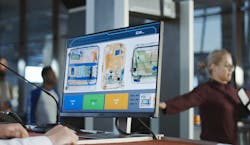Airport security experts to approach industry for new baggage screening technologies to speed passengers
WASHINGTON – U.S. aviation security experts are asking industry to come up with improved ways of screening airport passenger baggage for a wide variety of home-made explosives with reduced false-alarm rates, and an ability to speed airport passenger screening.
Officials of the U.S. Department of Homeland Security (DHS) Science and Technology (S&T) Directorate in Washington notified industry last week of the upcoming Advanced Checked Baggage Screening Systems project.
No response to this synopsis is requested; a full solicitation is expected for release later this year.
The screening of passenger baggage using traditional explosives-detection systems faces many challenges in developing a broadly applicable detection capability that addresses commercial, military, and homemade explosives threats, DHS officials explain.
Established primary checked baggage explosives-detection technologies evolved from medical X-ray systems that sense effective atomic number, and density of the screened objects.
Although these discriminators perform well for identifying commercial and military explosives, detecting home-made explosives can be tricky. Typically they are formulated with household ingredients, lack tight quality control, and have high variations in chemical composition.
As a result, detecting home-made explosives requires expanding detection parameters, which can result in ambiguities and mischaracterizations that can lead to high primary screening false alarms that require secondary screening. This results in increased labor, reduced screening throughput, and passenger delays.
DHS researchers are looking for improvements in current baggage-screening systems to provide an acceptable level of detection on all threats, significantly reduce screening false alarms, and improve overall screening throughput.
DHS experts want a net false alarm rate of less than 10 percent. To reach this goal, they want to identify advanced technologies that can increase the discrimination between home-made explosives and stream-of-commerce clutter in checked baggage.
DHS experts want technologies that significantly enhance current baggage screening system detection and false alarm capabilities; minor improvements are not of interest.
This project seeks to improve X-ray systems, material discrimination methodologies, and mature testbed prototypes into prototypes that can move from early technology to deployable solutions. This project has five technology areas:
Related: TSA eyes open-systems explosives detection for rapid airport security upgrades
-- development and testing of full-up system engineering design models;
-- threat-detection and false-alarm reduction algorithms for real-time prototypes;
-- system components and subsystems like X-ray sources and detectors to evolve laboratory prototypes into full-up X-ray system designs;
-- information methods to include new methods of baggage classification, screening, and transport to enable several parallel screening tiers to judge bag safety outside of X-ray technologies; and
-- integrating threat image projection software with current explosives-detection systems;
Each project that DHS experts choose will last from one to two years. Email questions or concerns to DHS's Carolyn Lethert at [email protected]. More information is online at https://beta.sam.gov/opp/f0566cf212e64c1b86d89b0a1c2ba86e/view.
About the Author
John Keller
Editor-in-Chief
John Keller is the Editor-in-Chief, Military & Aerospace Electronics Magazine--provides extensive coverage and analysis of enabling electronics and optoelectronic technologies in military, space and commercial aviation applications. John has been a member of the Military & Aerospace Electronics staff since 1989 and chief editor since 1995.
